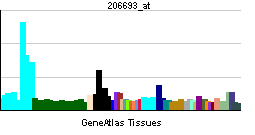De Wikipedia, la enciclopedia libre
La interleucina 7 es una citoquina de 27 kDa producida por las células del estroma de la médula ósea y por los fibroblastos . Actúa sobre los progenitores linfoide inmaduros, induciendo su desarrollo.[ 1] [ 2] [ 3] [ 4] [ 5]
↑ Namen AE, Lupton S, Hjerrild K, Wignall J, Mochizuki DY, Schmierer A, Mosley B, March CJ, Urdal D, Gillis S (1988). «Stimulation of B-cell progenitors by cloned murine interleukin-7». Nature 333 (6173): 571-3. Bibcode :1988Natur.333..571N PMID 3259677 doi :10.1038/333571a0 ↑ Goodwin RG, Lupton S, Schmierer A, Hjerrild KJ, Jerzy R, Clevenger W, Gillis S, Cosman D, Namen AE (1989). «Human interleukin 7: molecular cloning and growth factor activity on human and murine B-lineage cells» . Proc. Natl. Acad. Sci. U.S.A. 86 (1): 302-6. Bibcode :1989PNAS...86..302G PMC 286452 PMID 2643102 doi :10.1073/pnas.86.1.302 ↑ Sutherland GR, Baker E, Fernandez KE, Callen DF, Goodwin RG, Lupton S, Namen AE, Shannon MF, Vadas MA (1989). «The gene for human interleukin 7 (IL7) is at 8q12-13» . Hum. Genet. 82 (4): 371-2. PMID 2786840 doi :10.1007/BF00274000 ↑ Lupton SD, Gimpel S, Jerzy R, et al. (1990). «Characterization of the human and murine IL-7 genes». J. Immunol. 144 (9): 3592-601. PMID 2329282 ↑ Alves, BIREME / OPAS / OMS-Márcio. «DeCS» . Consultado el 18 de mayo de 2023 . 

